To build a great sketchbook habit, start by picking a sketchbook size you’ll actually carry, and choose thick, sturdy paper that won’t cry when you erase too much. Grab just a pencil and good eraser—no need to haul a full art store. Try sketching outside for fresh air and new ideas, personalize your cover with stickers, and don’t stress over “ugly” pages. Every scribble counts as practice, and with each tip, creativity just gets easier—stick around to reveal even more secrets.
Key Takeaways
- Choose a portable sketchbook with quality, heavyweight paper to encourage daily sketching and support various media.
- Use multiple sketchbooks to explore different themes, techniques, and track your artistic growth without creative pressure.
- Embrace quick, gestural sketches to build confidence, capture movement, and warm up your creativity.
- Experiment with mixed media and layering to discover new textures, effects, and keep the creative process exciting.
- Share your sketches with communities online for feedback, support, and inspiration throughout your artistic journey.
Choose the Right Sketchbook for Your Needs
Even before putting pencil to paper, choosing the right sketchbook can feel like picking your superhero sidekick—it totally changes the adventure.
For artists hoping to build a strong sketchbook habit, the decision starts with size and format. If someone is into small daily drawings, a compact and portable sketchbook—think A5 or smaller—makes it easy to slip into a backpack or jacket pocket.
Picture yourself doodling in a café or sketching a dog at the park; a small book calls you to action. Spiral-bound sketchbooks let pages turn easily or even pop out, great for sharing your art. Hardbound ones add a fancier touch if you prefer finished projects.
Want to sketch longer? More pages mean more adventures. Choose the right sketchbook, and every day feels possible.
Consider Paper Quality and Weight
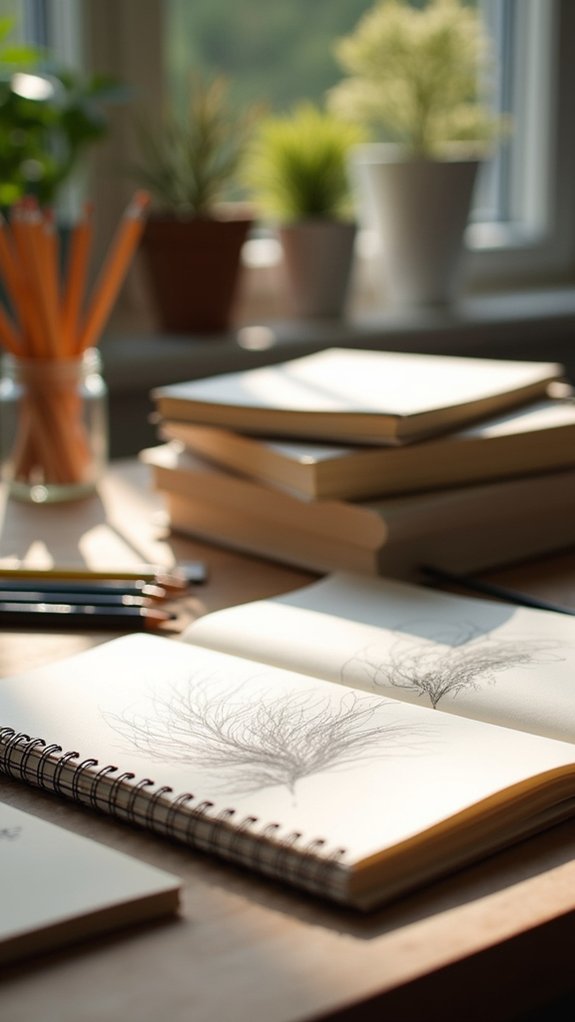
Paper isn’t just paper—some sheets can handle a splashy watercolor adventure, while others might buckle at the first drop.
The thickness and texture of your pages can make every pencil stroke feel magical or maddening, and sturdy, quality paper stands up to erasing and sketching over and over again.
Picking the right kind adds serious power to your mixed media experiments, keeps your drawings looking sharp, and honestly makes art way more fun.
Impact on Mixed Media
Mixed media art is like an epic science experiment—part painting, part collage, and maybe a dash of “What happens if I add glitter glue?”
But here’s a big secret: the kind of paper an artist uses can totally change the outcome of the project. If someone grabs any old sketchbook, that crazy mixed media experiment could turn into a soggy mess.
Paper quality makes all the difference. Heavyweight paper—think 200gsm or thicker—can handle water, ink, or sticky stuff without turning into a wrinkled disaster. Special sketchbooks labeled for mixed media are perfect for blending and layering all kinds of materials.
Always pick acid-free and archival-quality paper to keep colors bright. Trying out different papers can spark wild new ideas, giving art unexpected texture and depth.
Durability for Repeated Use
All those wild mixed media experiments are awesome—until the page falls apart after the tenth time it gets soaked, sketched, and erased.
Let’s be real, a sketchbook needs to be tough! When picking one out, don’t just go for the flashiest cover—durability totally matters. Artists everywhere have felt the heartbreak when a masterpiece rips or warps.
Here’s how to dodge that disaster:
- Pick paper with at least 200 gsm—the higher the weight, the stronger the page!
- Make sure your sketchbook paper is acid-free, so your coolest art doesn’t turn yellow or crumble.
- Thick pages are a must—they stand up to heavy erasing, layering, and even wet paint.
- Check the binding; spiral-bound sketchbooks lay flat and don’t trap art in the middle!
Texture and Drawing Experience
Imagine running your fingers over a fresh sketchbook page—that first touch can totally set the mood for your next masterpiece. Some artists crave smooth pages for super crisp, detailed lines, while others love a rougher texture for those bold, chalky strokes with pencils or pastels.
It’s like magic—quality paper seriously matters. Thicker paper, especially if it’s 200gsm or higher, handles paint, ink, and even the occasional splash of water without acting like a soggy napkin.
Over time, quality paper helps your sketches stick around, so no need to freak out about crumbling or fading pages. Remember, the right paper matches your favorite tools.
Feeling fancy with mixed media? Spiral binding and hefty paper make it easy to flip, draw, and experiment without worries.
Select a Binding That Fits Your Workflow
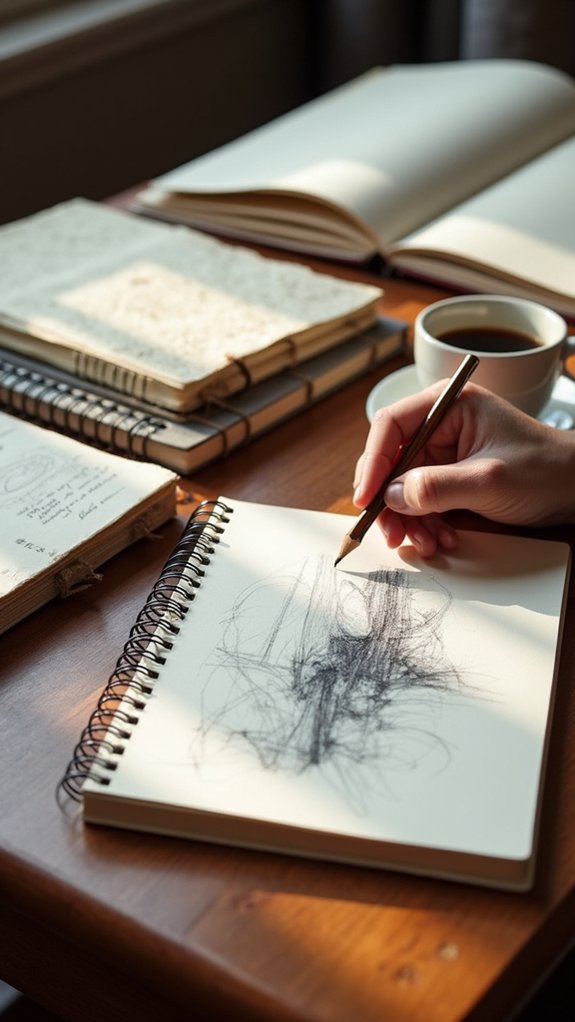
Ever wondered why some artists seem to zip through their sketchbooks while others wrestle with stubborn spines and pages that just won’t lay flat?
The secret often comes down to picking the right binding for your sketchbook. Usability can make or break your creative flow.
Spiral-bound sketchbooks let you tear out pages, which is perfect if you like to fix mistakes or share your art. Hardbound sketchbooks give your projects a durable, professional look and keep everything together for ages.
Some pretty awesome bindings even let your sketchbook lay totally flat—hello, easy scans and hassle-free drawing!
- Frustration-free drawing: flat-laying binding means more fun, less fighting with pages.
- Show-off moments: hardbound covers make sharing finished art feel special.
- Easy edits: spirals mean page-pulling power.
- Ultimate satisfaction: a binding matched to your style boosts creativity.
Keep Your Materials Simple and Portable
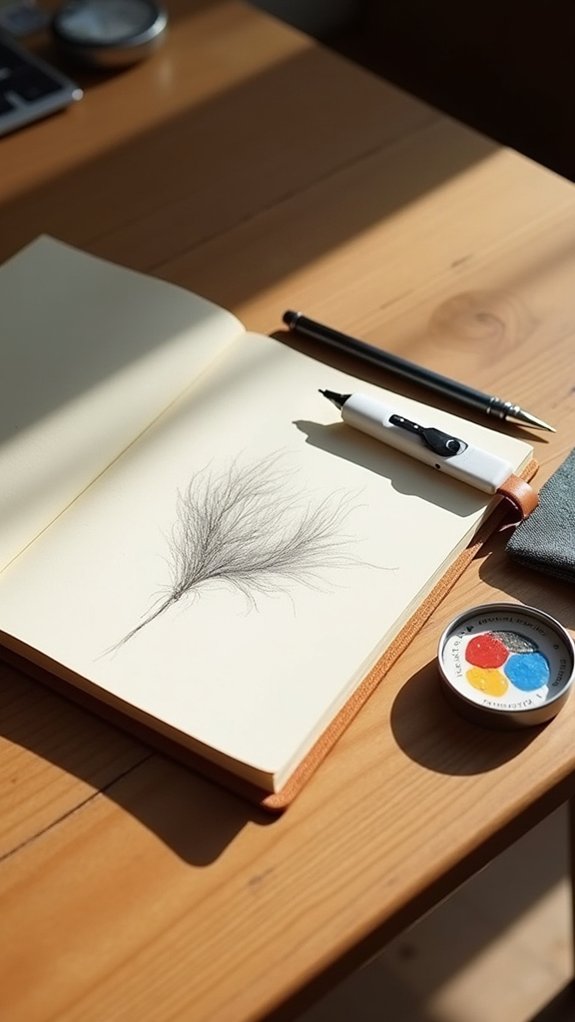
Smooth sketchbook skills aren’t only about what’s holding your pages together—the stuff *inside* the sketchbook matters just as much.
Keeping materials simple and portable can totally change the game. Imagine lugging around a giant art set versus just sliding a small A5 sketchbook, a pencil, and an eraser into your backpack. Easy, right?
If you keep things light, you’re way more likely to sketch whenever inspiration hits—standing in line, sitting under a tree, or hanging out at your desk.
Use your sketchbook to explore simple shapes, not complicated masterpieces every time. Pick a vista-format sketchbook with sturdy pages, so it handles random doodles or quick color splashes.
Fewer supplies mean less stress and more creativity, freeing you up for fun, on-the-go art adventures!
Start With Basic Drawing Tools
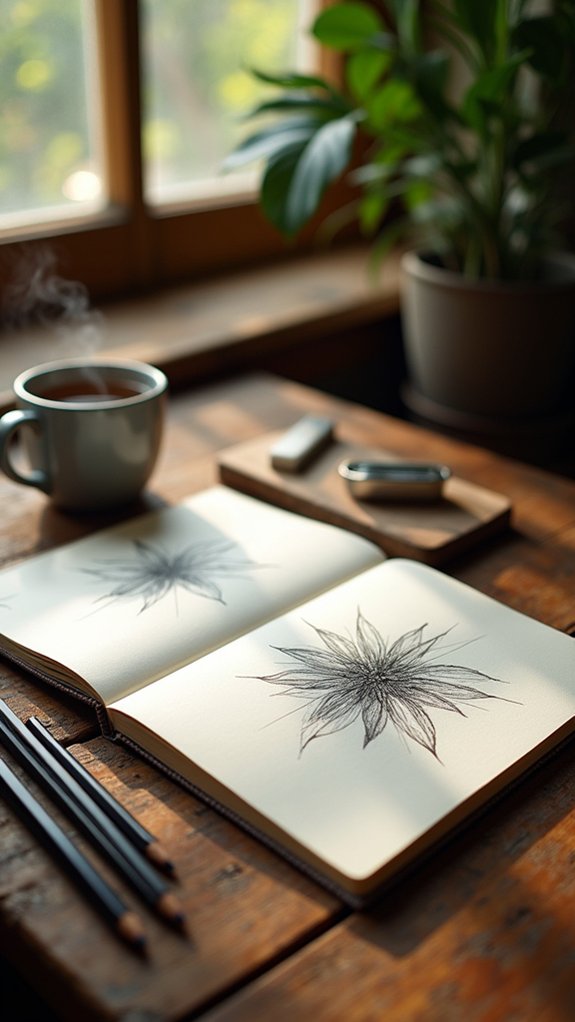
Before getting fancy with loads of art supplies, every artist should start with just the basics—think a good pencil, eraser, and maybe a trusty sketchbook small enough to toss in a backpack.
Simple tools are not only easier to carry, but they help keep the focus on making art, not fussing over which gadget to use.
Packing a portable art kit also means sketches can happen anywhere, whether it’s at the park, in class, or secretly doodling during a boring family dinner.
Essential Sketching Supplies
Supplies can make or break the sketching experience, especially for someone just starting out.
The right gear isn’t just about looking cool—it actually helps artists stay excited and creative. Choosing a simple sketchbook, a favorite pen or pencil, and some quality paper takes away the stress of decision-making and lets creativity shine.
Who wants to lug around a suitcase of art stuff when a pocket-sized A5 sketchbook can go anywhere? Tough decisions, right?
Here are four essentials every sketch artist should seriously consider:
- Small, portable sketchbook—Your new travel buddy for ideas and doodles.
- Reliable pen or pencil—Less smudge, more style!
- Solid eraser—Mistakes? Not scary anymore.
- Quality paper—Handles rough sketching and a splash of watercolor without tears.
Choosing Simple Materials
Simplicity is every artist’s secret weapon, even if it doesn’t look flashy. When keeping a sketchbook, it’s easy to feel lost in a sea of art supplies, but starting with basic drawing tools makes a huge difference. Think: a small A5 sketchbook, one nice pencil, a trusty eraser, and maybe a black Prismacolor or Sharpie marker. That’s it. With just these, you have time to sketch wherever you go, whether it’s at lunch, on a bus, or hiding from chores. Use a simple watercolor set and a few brushes if you want to explore ideas with color—no pressure, though. Remember—perfection isn’t the goal. The real win is making space for mistakes, growth, and a ton of creative discoveries.
| Joy of Sketching | Freedom | Growth |
|---|---|---|
| Messy lines | Quick doodles | Brave starts |
| Happy accidents | Daily practice | New ideas |
| Small victories | No pressure | Personal best |
Portable Art Toolkits
Carrying a monster bag stuffed with every art supply known to humankind can zap the fun right out of sketching.
That’s why a portable set of tools is a creative game changer. Starting simple keeps sketching exciting rather than stressful, making it so much easier to sketch in the park, on the bus, or even during a boring class lecture (don’t tell your teacher).
Here are four must-have portable art tools to stash in your kit:
- A lightweight A5 sketchbook—small, sturdy, and ready for action.
- A sharp pencil and reliable eraser—get those ideas down, then tweak as needed.
- A mini watercolor palette and a couple of brushes—just the right amount of color power.
- Smudge-proof pens or black Prismacolor pencils—hello, vibrant, mess-free art!
Embrace Imperfect and “Ugly” Sketches
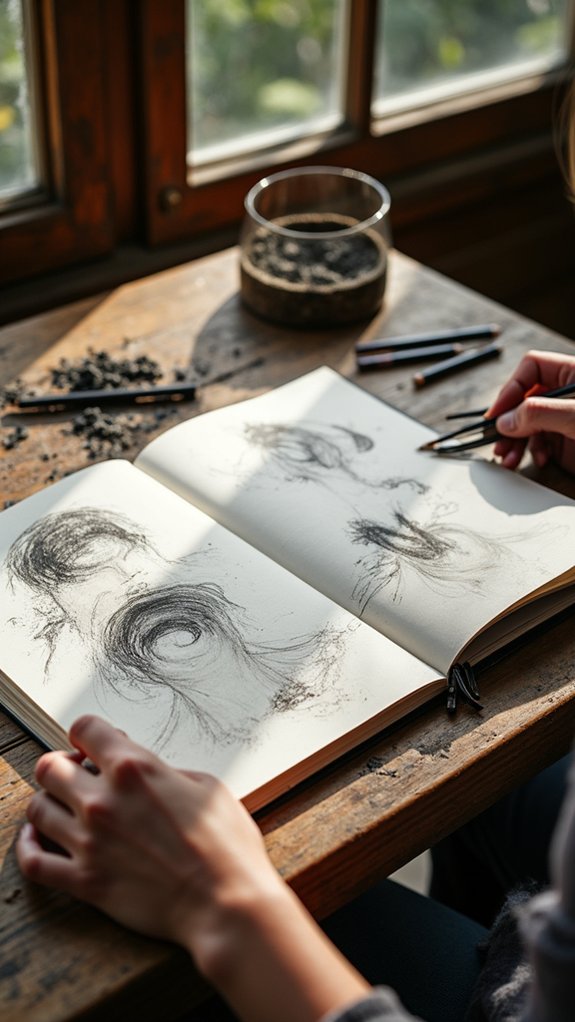
Perfectionism has a sneaky way of creeping into a sketchbook, making every little flaw look ten times bigger than it really is.
But here’s the secret—when artists embrace imperfect and “ugly” sketches in their daily sketchbook, magic starts to happen! Letting go of the urge for every drawing to be a masterpiece can actually boost creativity and growth.
Instead of worrying about smudges or weird hands, they get to experiment, make mistakes, and actually learn from them. Filling a sketchbook with raw ideas—no matter what they look like—makes the artistic journey way more fun.
Over time, those so-called “ugly” sketches turn into lessons, confidence builders, and springboards for new ideas.
Besides, who wants a sketchbook full of perfect, boring art?
Set Realistic Daily or Weekly Goals
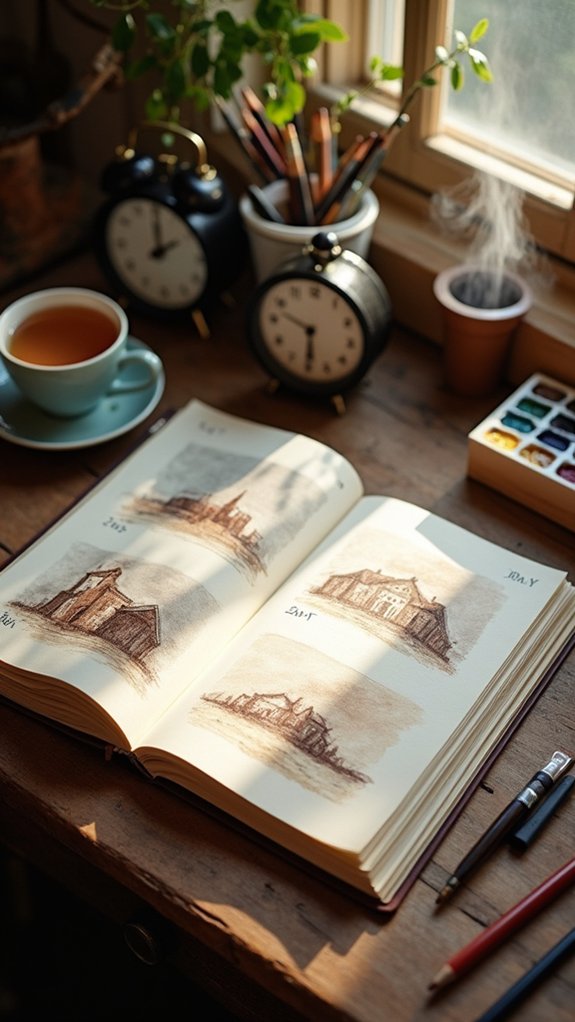
For any artist with a sketchbook, setting daily or weekly goals can totally change the game.
Having clear sketching goals helps keep up that creative streak, instead of letting your sketchbook collect dust in a drawer. It doesn’t have to be an epic quest—just ten or fifteen minutes a day is enough to build serious commitment, and it takes the pressure off making every sketch a masterpiece.
Flexibility matters, too, because let’s be real—life sometimes gets in the way, and that’s totally fine.
Here’s how to make those goals work for you:
- Set small, chill sketching goals so you don’t burn out.
- Track your commitment by marking progress inside your sketchbook.
- Adjust your routine—some weeks are wild!
- Celebrate every win, no matter how tiny!
Use Your Sketchbook to Record Ideas and Inspiration
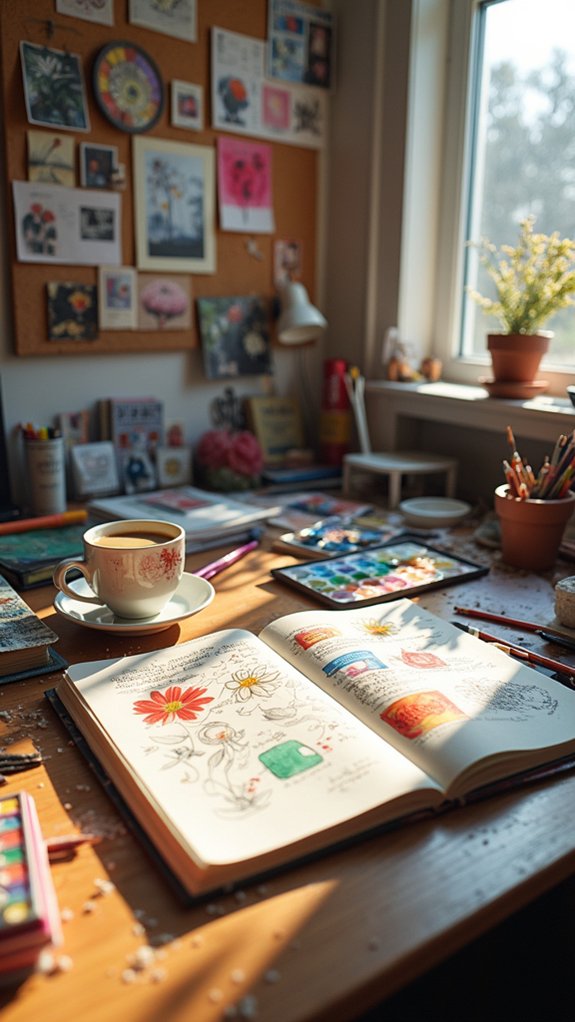
Even if it feels like inspiration only pops up at the weirdest times—like in the shower or halfway through math class—a sketchbook has the magical power to catch those lightning-bolt ideas before they vanish.
It’s more than a book; it’s a secret hideout for doodles, wild ideas, and stuff you overhear on the bus that just sticks with you. Some artists even treat their sketchbook like a journal entry, writing about their struggles or dreams right next to their drawings.
Revisiting old pages can be hilarious (“Did I really draw that?”) but also motivating, sparking fresh inspiration for new projects.
Nature journaling, too, lets you capture the feeling of being outside—suddenly, a leaf or rainstorm becomes immortal on the page.
Experiment With Mixed Media Techniques
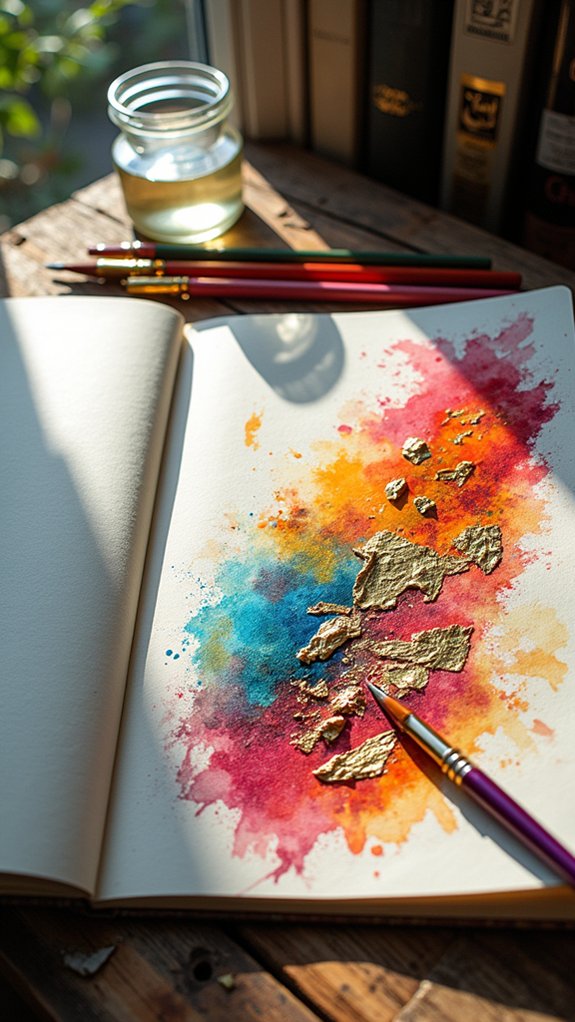
Trying out mixed media in your sketchbook can be a fun adventure, especially when you layer paint and ink or sneak in some collage pieces cut out from magazines.
Suddenly, a simple drawing gets new textures and pops with cool effects—kind of like giving it a secret superpower. Just imagine the surprise when glue, watercolor, and pen all team up to make your art stand out from the crowd!
Layering Paint and Ink
Plenty of artists find that layering paint and ink is like building a secret world right on the page—each layer adds more excitement, more twists and turns.
Mixing different materials, or mixed media, opens up possibilities for creating wild, unforgettable texture in your artwork. Imagine ink swirling into wet watercolor, or thick acrylic catching the light in surprising ways—there’s something almost magical about it.
But patience is key: each layer has to dry before the next one goes on, or things get muddy fast. And don’t even think about using thin notebook paper unless you want a soggy disaster!
- Feel the thrill of depth as you watch your secret world grow.
- Savor the shocks and surprises that every new texture brings.
- Get wild with unexpected tools—brushes are just the beginning.
- Trust the process—each step matters (even drying time)!
Combining Collage Elements
When an artist starts mixing collage elements into a sketchbook, it’s like throwing a surprise party for their art supplies—anything can happen, and that’s half the fun. By adding collage pieces, everything from colorful scraps of magazine pages to dried leaves or pressed flowers, an ordinary sketchbook explodes with personality.
Mixed media techniques invite wild creativity, letting artists layer papers, photos, and textures for awesome, unpredictable results. Glue sticks or gel mediums hold things down, so nothing escapes or falls out of your book like confetti.
Sometimes, bits and pieces overlap in weird ways, but that’s where real magic happens. Every unexpected texture and happy accident tells the story of your artistic journey—one gluey, layered, totally original page at a time.
Capture Observations From Life
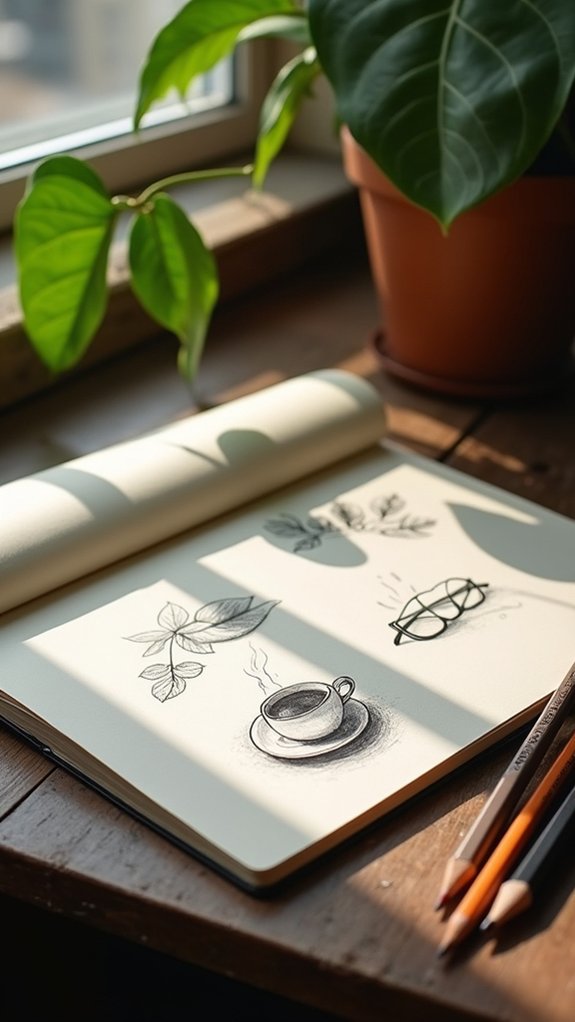
A sketchbook can become an artist’s secret superpower, especially when it comes to capturing the world as it happens right in front of them.
Observational drawing from life—yeah, actually drawing the people, places, or even your sandwich—helps boost your skills like nothing else. Suddenly, figuring out tricky shapes or weird angles starts to make sense.
The more you grab your sketchbook and immerse yourself, the more you’ll notice your unique artistic style shining through. There’s even a little thrill in catching a moment before it’s gone!
- Witness tiny details you never noticed before—like a lizard on a brick wall.
- Feel amazed as your sketches get better and better with each page.
- Treasure memories, making regular days feel magical.
- Discover what inspires you most, fueling future creativity.
Establish a Sketching Routine That Suits You

Everyone has a different daily rhythm, so artists should pick a sketching time that actually fits their own life, not someone else’s.
Maybe that means drawing during a quiet breakfast or sneaking in quick sketches while waiting for the bus—whatever works, as long as it feels right.
There’s no one-size-fits-all schedule here, and finding that sweet spot can change an ordinary day into a creative adventure.
Find Your Ideal Time
How does an artist really know the best time to pick up a pencil and start sketching?
Sometimes, figuring it out feels like a mystery—but it doesn’t have to be! Artists should check their daily routine, from time to time, to spot when creativity naturally sparks.
Maybe it’s during morning coffee or late at night before bed, just don’t forget to keep things fun, not forced. Making a sketch shouldn’t feel like homework—it’s your time to relax and play.
- Try drawing during four different times this week to see which feels right.
- Keep your sketchbook handy, because inspiration doesn’t send a calendar invite.
- Notice when making a sketch feels easiest—chase that feeling!
- Let sketching become your delight, not your duty.
Adapt Routine to Lifestyle
Once someone figures out the moments when sketching feels the most fun, the next big question is: how to actually fit that time into real life?
Life is wild, and routines can get tricky fast. Assess your daily schedule—look for little pockets of time where your sketchbook can tag along, maybe while waiting for the bus or during lunch.
Stash your sketchbook somewhere portable, so even a five-minute break becomes a chance to draw. Set sketching goals that aren’t overwhelming; some weeks might be doodle-crazy, others not so much. That’s normal!
Try Quick Gestural Sketches to Loosen Up

Plenty of artists have felt stuck staring at a blank page, waiting for inspiration to magically appear, but quick gestural sketches can zap some energy into that moment.
Instead of stressing over making things perfect, these speedy drawings—often just one to three minutes—let artists embrace a real sense of freedom. A gestural sketch focuses on movement and capturing the essence, not nitpicking every detail.
Shaky lines? Weird proportions? That’s all part of the fun! Making quick gestural sketches helps warm up the mind and hand, while keeping doubts at bay.
- Imagine blowing away frustration as you scribble out a free, loose sketch.
- Each gestural drawing lets you express feelings, not just shapes.
- Sketching quickly can turn nervous jitters into pure creative energy.
- Freedom comes when you let those lines dance!
Use Your Sketchbook to Plan Larger Projects
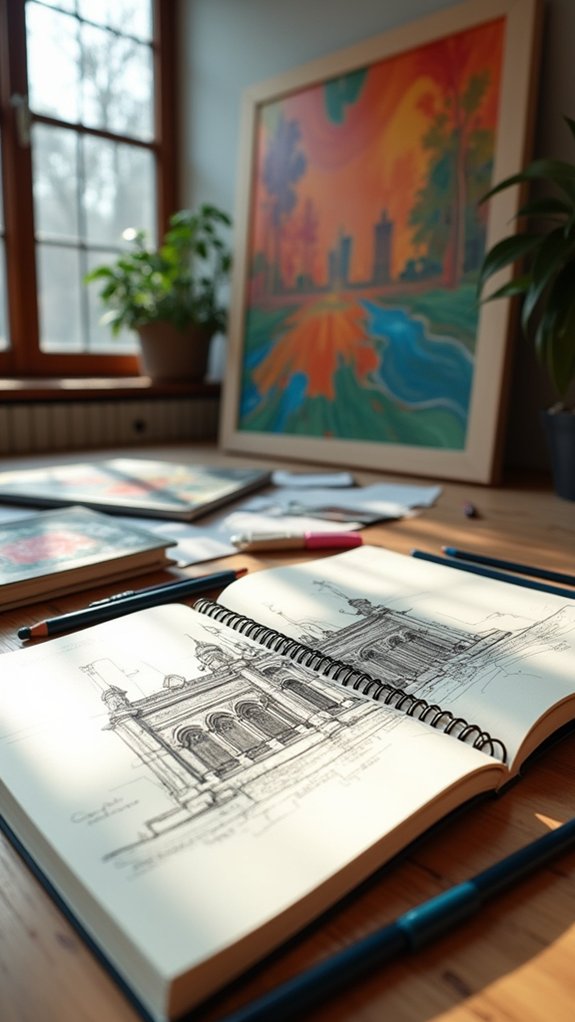
Planning a big art project can feel overwhelming, but a sketchbook turns it into a fun adventure.
Artists often use quick thumbnail sketches to play around with different compositions, kind of like testing puzzle pieces before locking them in place. It’s also a perfect spot to mess with color palettes—if your sky turns out neon green by accident, no one has to know but you!
Thumbnail Sketches for Composition
Before diving into a huge, intimidating masterpiece, artists have a not-so-secret weapon: thumbnail sketches. These tiny, speedy drawings make a huge difference when it comes to planning composition. Instead of risking a creative meltdown on a huge blank sheet, artists can let loose and play around in the safety of their sketchbook.
Thumbnail sketches are all about experimenting—changing layouts, trying weird proportions, and flipping the page for fresh orientations. That “a-ha” moment comes when a small scribble suddenly has the potential to become something amazing.
Here’s why thumbnail sketches truly matter:
- They save time and keep frustration from taking over.
- They make it easy to compare lots of ideas at once.
- They encourage wild, creative risks—without consequences.
- They boost skills in composition (and confidence, too!).
Testing Color Palettes
After nailing down an awesome composition with thumbnail sketches, attention shifts to the next thing that can totally make or break a piece: color choices. Instead of jumping right into a big canvas and hoping the blues and oranges play nice, artists whip out their sketchbook and start to experiment.
Testing color palettes in a sketchbook is like running a dress rehearsal for your masterpiece. Make tiny swatches of different combos, scribble out gradients—maybe even invent a shade that sounds like a sports drink flavor. Noticed that neon green magically pops next to deep purple? Write that down!
Jot notes about lighting and layering too, since paint can change its mind when things get bright or soggy. Keep a section for palettes that actually work—you’ll thank yourself later.
Keep Multiple Sketchbooks for Different Purposes
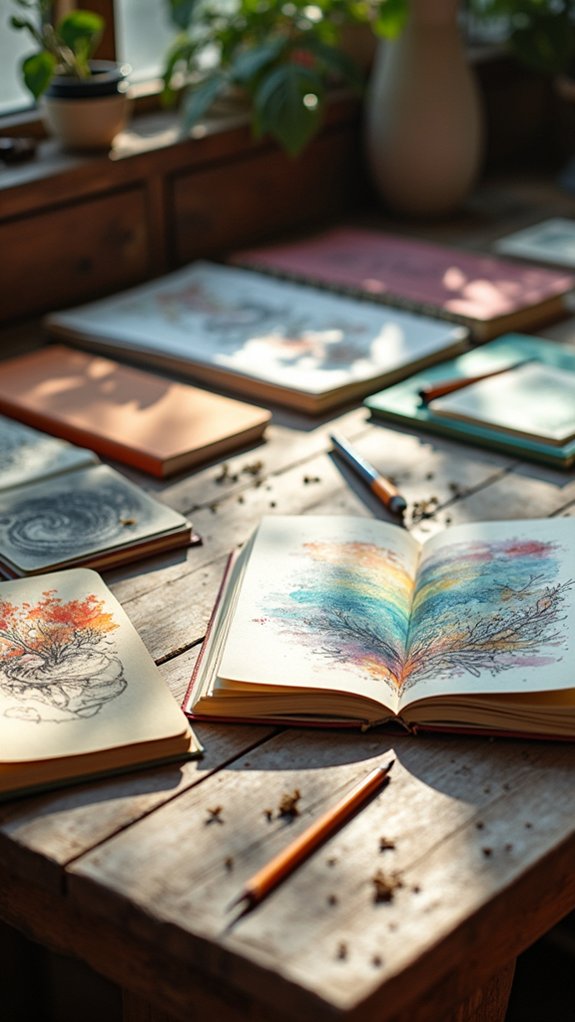
Though it might sound a little wild at first, lots of artists actually keep a bunch of different sketchbooks for different reasons—and it totally works.
It’s like having a toolbox for your creative practice, with each sketchbook fitting a specific need or mood. Not every page has to be perfect; some sketchbooks capture quick, silly doodles while others are for deep, detailed art studies.
This way, artists get to experiment, track their artistic growth, and never run out of ideas.
Here’s why juggling multiple sketchbooks is actually genius:
- Different sizes and types fit different places and moments.
- Each book can focus on a special theme (hello, pet squirrels or city skylines).
- Flipping back helps artists see how much they’ve improved.
- It totally removes pressure—just pure, creative freedom!
Participate in Sketching Challenges

Jumping into a sketching challenge, like one of those month-long art marathons, can seriously boost your consistency, even on days when you’d rather draw a stick figure and call it quits.
These challenges push artists to break out of their comfort zones, try weird prompts, and maybe surprise themselves with what their pencils can do.
Plus, watching that progress stack up day after day feels a bit like revealing new levels in a game, but with way more messy eraser shavings.
Building Consistency Through Challenges
Sketching challenges are like boot camps for creativity, pushing artists to show up and draw day after day—even when their pencils feel heavy or their inspiration is running low.
Joining a 30-day sketchbook challenge isn’t just about drawing; it’s about building consistency and forming a solid habit you can actually stick to. Setting personal goals helps keep everyone accountable, and sharing your journey online turns stubborn solo practice into a team effort.
Sure, not every page will be a masterpiece, but that’s the point—progress, not perfection! Each page becomes proof that you kept going, even on tough days.
- Celebrate showing up, even when it’s hard.
- Set goals—tiny or huge—they all count.
- Laugh at your mistakes and keep sketching.
- Share and cheer for friends on the same journey!
Expanding Creative Boundaries
Sometimes, all it takes is one bold step—like diving into a sketching challenge—to shake up what feels possible with a pencil and page.
Imagine someone explicitly requested you try drawing dinosaurs for a week, or even put together a list of wild things to sketch—suddenly, you’re testing limits you didn’t even know you had.
Sketching challenges push artists to break out of their comfort zone, whether it’s tackling wacky new topics or experimenting with funny techniques.
Sharing finished pages on social media lets artists connect, swap funny stories, and celebrate wins together (even if your cat portrait ends up looking like a soggy loaf of bread).
It’s about progress, not perfection, and over time, all those awkward sketches lead to real creative growth.
Draw What You See, Not What You Think
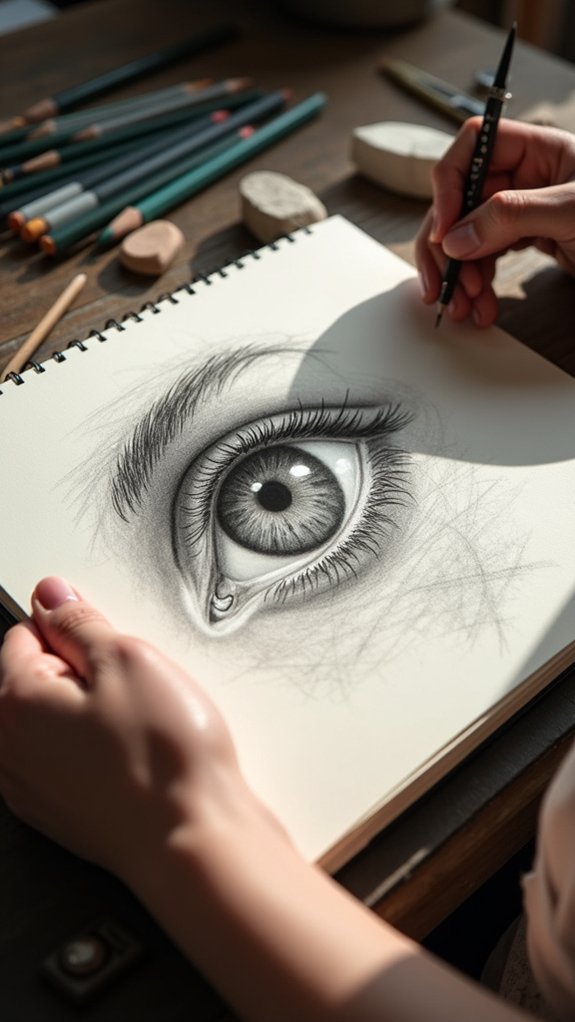
Observation is like a superpower for artists who want to create drawings that actually look real. Instead of imagining what an apple “should” look like, an artist grabs their sketchbook and dives into observational drawing—only drawing what their eyes see.
This simple switch makes a huge difference, especially when trying to get accurate proportions, truthful shapes, and real-life vibes. Hilariously, our brains love to guess or fill in blanks, but that often leads to weird noses and lopsided cups! Good news: training your eyes takes practice, not magic.
Here’s why looking closely changes everything:
- Noticing tiny details brings plain objects to life.
- Learning from mistakes drives improvement.
- Honest observation builds confidence.
- Drawing exactly what you see feels surprisingly powerful—like revealing a hidden world!
Share Your Progress With Others
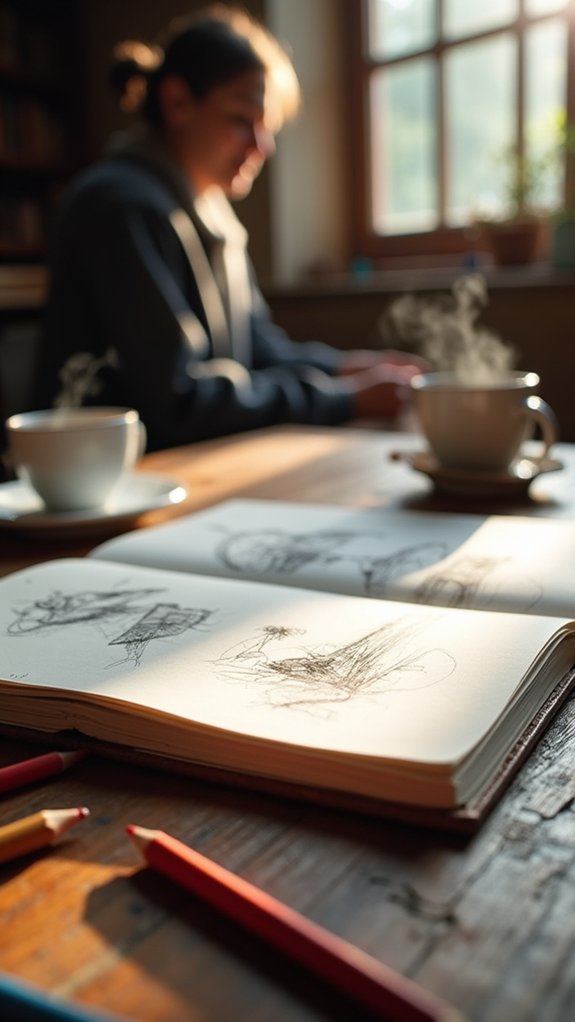
Even though sharing drawings with others might feel scary at first—kind of like showing a diary full of secrets—it can totally flip an artist’s mindset for the better.
When artists share your progress, whether it’s one drawing or a whole page, it can actually help us grow braver and more motivated. Social media makes it easier to connect with other sketchers, and that means more support and possible feedback (the kind that doesn’t sting, promise!).
Suddenly, perfection stops being the boss, and progress takes over. Plus, when artists post sketches and write about what they’re learning, it inspires others to take the leap, too.
Sharing isn’t just about showing off skills; it’s about encouraging each other through all the weird, wonky stages of creativity.
Reflect on Past Sketchbooks for Growth
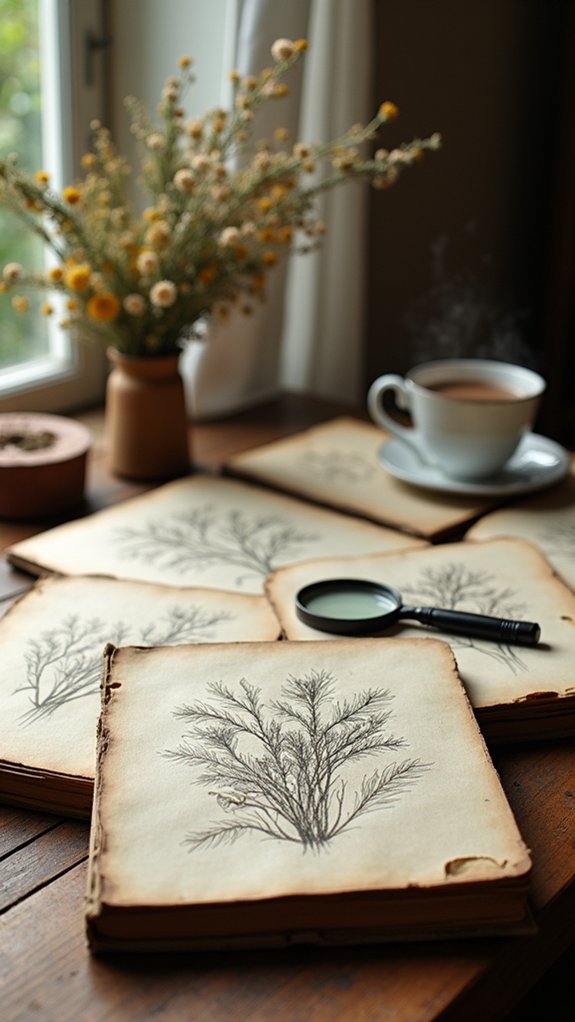
Flip back through old sketchbooks and it’s almost like finding a secret time machine—suddenly, pages filled with scribbles and awkward doodles become a map of how far an artist has come.
Sketchbooks aren’t just stacks of paper; they’re basically journals full of creative struggles, victories, and that one phase everyone kind of wishes they’d skipped.
When artists reflect on their progress, they can notice subtle growth that felt invisible in the moment but stands out in hindsight.
These beats of creativity, the wins and fails, are all part of the story.
- Look at how your style and technique have changed—notice the brave risks.
- Be proud of tackling tough sketches, even if they’re a little messy.
- Read old notes for a boost of motivation.
- Celebrate growth, then set new goals.
Incorporate Writing or Lists Alongside Drawings
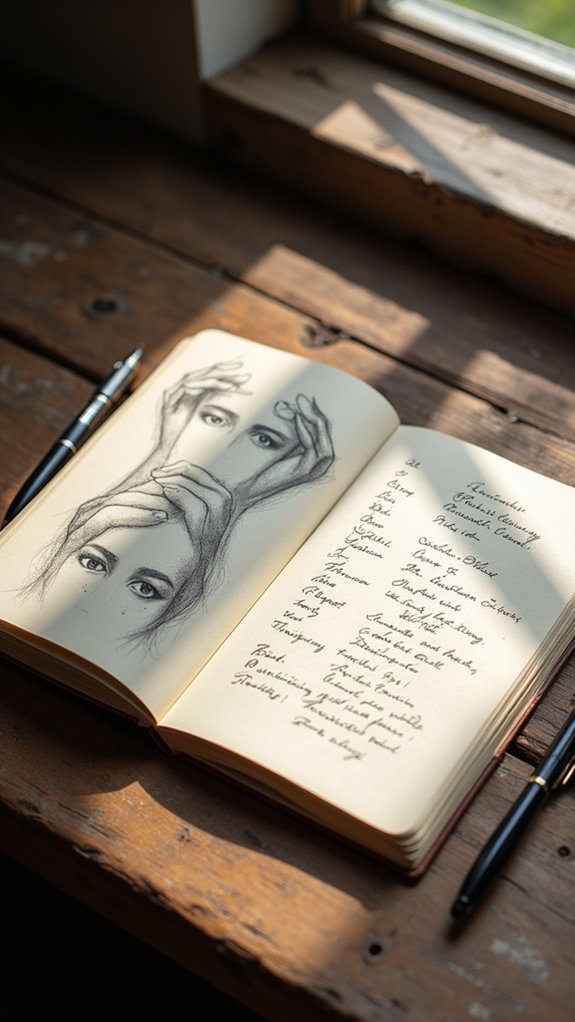
Sometimes, going through old sketchbooks feels like flipping through the pages of someone else’s adventure story—with each drawing marking a new chapter. But imagine if those chapters had secret messages, wild ideas, or to-do lists scribbled in the margins! Adding writing and lists turns a plain sketchbook into a real journal, mixing words and sketches to capture what sparked each drawing. Jotting down thoughts, describing that weird-looking dog at the park, or listing new techniques to try makes every page pop with energy. This blend helps track progress and brings out new creative sparks. Here’s how it might look:
| Sketch Concept | Notes & Writing | To-Try List |
|---|---|---|
| Treehouse design | “Inspired by old movies” | Use colored pencils |
| Street scene | “Night, smells like rain” | Try ink wash |
| Portrait | “She was laughing” | Practice shading |
| Fantasy creature | “Dream last night!” | Study animal anatomy |
Reward Yourself for Reaching Milestones

Celebration fuels motivation like nothing else—think of it as confetti for the creative brain.
When someone hits a milestone in their sketchbook journey, even a tiny one, it’s like reaching a hidden treasure chest. That’s the perfect time to reward yourself! Recognizing achievements keeps self-doubt at bay and makes you want to fill even more pages.
Whether you’ve finished a sketchbook or just added your fiftieth doodle, don’t let it slip by unnoticed!
- Buy yourself a fancy new pen or pencil—your creative spirit totally deserves it.
- Treat yourself to your favorite snack to savor creativity (hello, jellybeans!).
- Go on a mini art-adventure, like drawing in a new park.
- Write down your sketchbook milestones and rewards; let those wins inspire you!
Use Stickers or Collage to Personalize Your Sketchbook
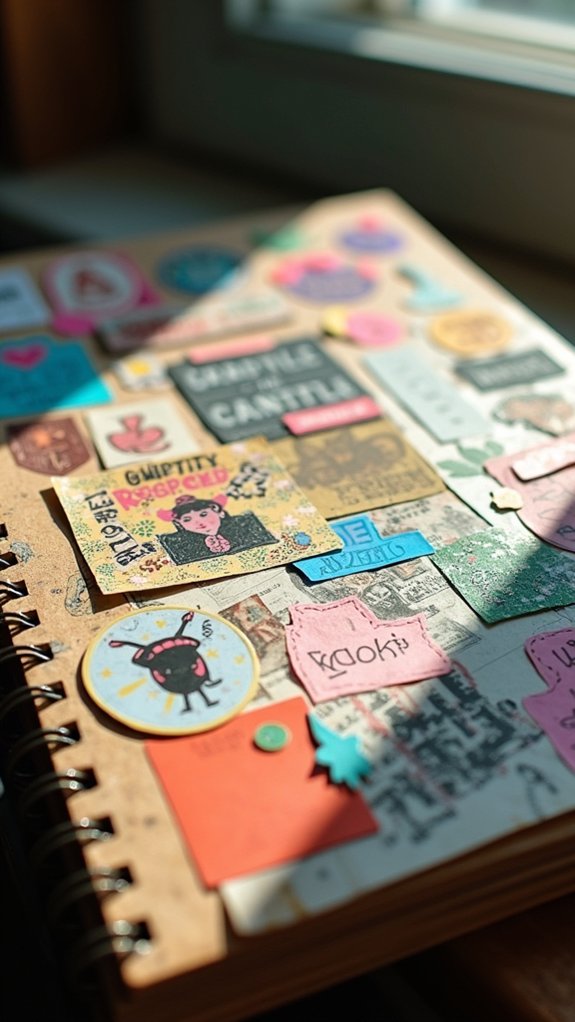
Rewards are awesome, but why stop there when the outside—and inside—of a sketchbook can be just as exciting as the art itself? Personalization is key! Adding stickers or collage elements turns any plain notebook into a bold, unique reflection of an artist’s style.
With every sticker slapped on and each bit of collage glued down, the sketchbook feels more like a sidekick than just a tool. Bright images, favorite bands, or magazine cut-outs can spark wild new ideas and even make the blank pages less intimidating.
Trying out different textures and colors in a collage can lead to all sorts of happy accidents. Plus, a decorated sketchbook tells a story, helping artists remember the creative journey and making them want to fill every page.
Sketch Outdoors to Connect With Nature
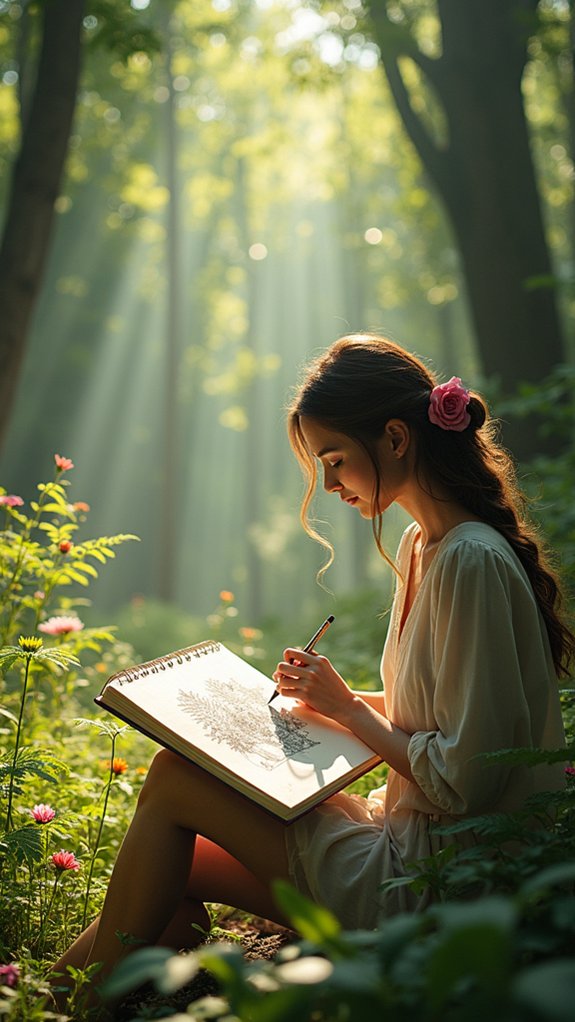
There’s something magical about taking a sketchbook outside and letting the breeze, sunlight, and world around inspire the next doodle or masterpiece.
Making a sketchbook comes alive when artists grab their pencils and step into nature. On that first day outdoors, the pressure fades, and artists become less likely to worry about perfection. Sketching trees or wildlife releases creativity—you never know what might run, soar, or grow into your pages! It might feel intimidating at first, but the rewards are worth it.
- Feel your worries melt away as sunlight and birdsong fill the air.
- Capture fleeting moments—cloud shapes, rustling leaves, or a squirrel’s dance.
- Build observation skills, discovering things never noticed before.
- Make memories that turn into art—unexpected, silly, or beautiful!
Don’t Be Afraid to Scrap or Skip Pages

Tossing a messed-up page or skipping ahead in a sketchbook might sound scary at first, but it’s actually a secret weapon for every artist. Seriously, even someone like Van Gogh didn’t get masterpieces every time he picked up a brush—just ask any blog post or peek into magazine archives! Scrapping pages isn’t a failure; it’s proof you’re experimenting. Every artist has “whoops” days, but ripping out, gluing together, or just skipping those pages can keep the fun in art and the pressure out.
Here’s a quick look at why skipping pages rocks:
| Myth | Reality | Famous Example |
|---|---|---|
| Every page must be perfect | Progress matters more than perfection | Van Gogh’s sketchbooks |
| Skipping is quitting | Skipping is creative freedom | Blog post confessions |
| Mistakes = failure | Mistakes = growth | Magazine archives |
Focus on the Process Over the End Result
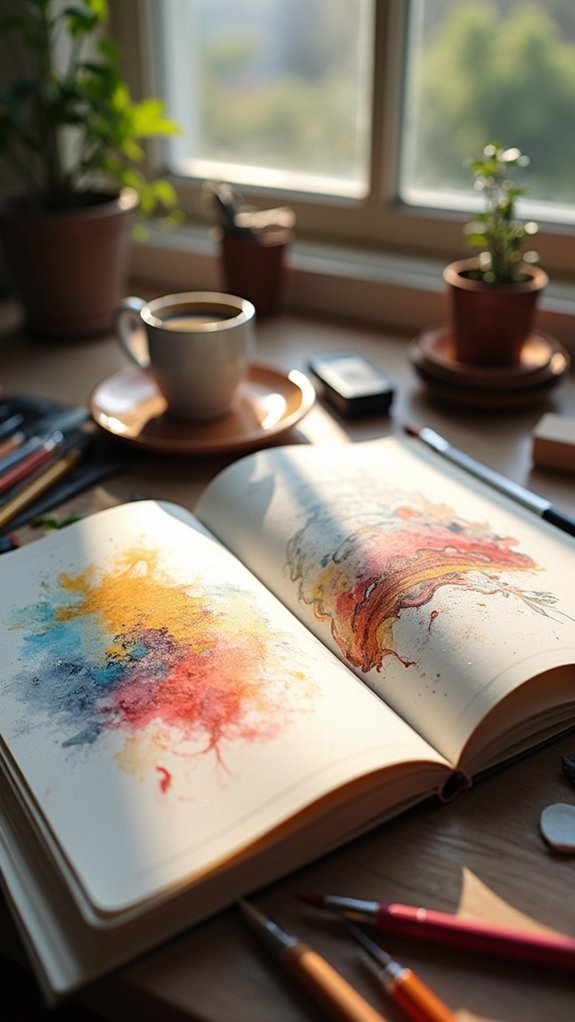
Even though it’s easy to get caught up chasing the perfect drawing, artists who decide to focus on the process instead of just the final picture often find way more fun and freedom in their sketchbooks.
Sketchbooks are meant for wild ideas, messy lines, and surprises–not for perfection. With a strong process focus, every page becomes a part of an ongoing artistic journey.
Mindful sketching helps artists relax, reflect, and sometimes even laugh at their own mistakes. The real magic? It’s not just what’s on each page—it’s the story those pages tell.
- Forget perfection; let sketching be about experimenting and just having fun!
- Every sketch documents your milestones; flip back and see how far you’ve come.
- Mindful sketching turns art into calming, creative “me” time.
- Growth matters more than flawless pages—enjoy the adventure!
Frequently Asked Questions
How Do I Overcome the Fear of the Blank Page?
Overcoming the fear of the blank page often involves utilizing sketching prompts, practicing creative exercises, and adopting mindset shifts. Approaching each page as an opportunity rather than a challenge helps break mental barriers and encourages artistic exploration.
Can Digital Sketchbooks Replace Traditional Ones?
The question explores whether digital sketchbooks can replace traditional ones. Digital advantages include convenience and unlimited editing, while traditional techniques offer tactile experiences. Ultimately, both mediums support creative flexibility, allowing artists to select tools that best suit their preferences.
How Can I Protect My Sketchbook From Damage Over Time?
To prevent damage over time, artists should consider sturdy sketchbook covers for physical protection, utilize archival storage to safeguard against environmental factors, and apply protective sprays to shield pages from smudging, moisture, and fading, ensuring long-lasting preservation.
What Should I Do if My Sketchbook Gets Wet or Stained?
When a sketchbook becomes wet or stained, immediate action helps. Wet paper solutions include gentle blotting, air drying methods, and pressing pages flat. Stain removal techniques involve using a soft eraser or archival-safe cleaner, depending on the stain type.
How Do I Handle Criticism of My Sketchbook Work?
When receiving criticism of their sketchbook work, an artist can view constructive feedback as a valuable tool for personal growth. Approaching critiques with openness fosters artistic resilience, encouraging improvement while maintaining confidence in their creative journey.
Conclusion
So, sketchbooks aren’t just for perfect drawings—they’re playgrounds for creativity, a little messy, sometimes wild, and always personal. Everyone’s pages will look different, and that’s the magic. There will be experiments, doodles, maybe even a suspicious coffee stain or two. But every mark is progress! If you mess up? Flip the page and keep going. The real secret: have fun, trust your process, and honestly, never be afraid to draw weird-looking cats.


Leave a Reply